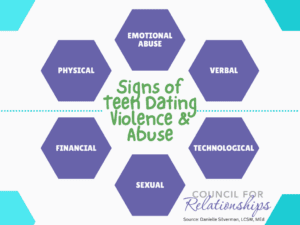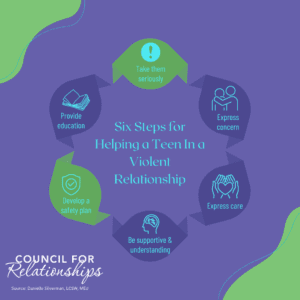Signs of Teen Dating Violence
February is Teen Dating Violence Awareness Month when we focus on recognizing and understanding signs of teen dating violence.
Teen dating abuse is a massive problem. It can manifest in different ways, like hurting someone emotionally or physically, controlling them, or harassing them online. Friends and family are pivotal in identifying warning signs, offering support, and guiding teens toward healthy relationships.
Identifying abusive behaviors, such as jealousy or emotional abuse, is crucial for intervening in a harmful relationship. Abusive relationships can include physical violence and psychological control, like unhealthy patterns in phone, email, and social media interactions.
By teaching teens and their supporters about these signs, we can promote more conversations about healthy and abusive relationships. The Domestic Violence Hotline helps people in abusive situations by giving assistance and stressing the need for a safety plan.
Teen dating violence is complicated, but it’s important to know that nobody should be in an abusive relationship. Support for both victims and abusers who want to change is available.
Having the Hard Discussions about Teen Dating Violence
Discussing abuse in relationships is hard. Signs of teen dating violence are even scarier for parents and educators to discuss.
1 in 12 teenagers go through physical or sexual abuse while in a relationship. However, there are parents and teenagers who are unaware that they are in an abusive relationship. 1 in 3 American teens experiences abuse from a dating partner, which can be emotional, physical, or sexual. Female and LGBTQ+ teens face higher rates of dating violence.
The shocking numbers likely underreport the true extent of dating abuse because of the shame associated with it.
Whether you are a teen, a parent, or someone who works with teens, here are some tips for addressing and preventing teen dating abuse.
Signs of Teen Dating Violence & Abuse
Frequently, we only consider physical or sexual abuse as part of an abusive relationship. Six different types of abuse that can occur in a relationship. The following are those six types with examples to help you better understand the signs of teen dating violence and abuse:
Emotional Abuse
- Constantly putting others down
- Showing extreme jealousy or unease
- Isolating someone from their family or friends
- Deciding who they can and can’t talk to or hang out with
- Possessiveness
- Public embarrassment (online or in person)
- Telling someone what to do or what to wear
Verbal
- Cursing
- Explosive temper
- Threatening to harm others
- Threatening suicide
- Extreme Mood Swings
Technological
- Demanding passwords to phone, email, and social media apps
- Monitoring text messages and phone call log
- Controlling posts or followers on social media
- Sending threats via text, social media or email
- Stalking
- Hacking social media or email
- Constant texting or calling
Sexual
- Rape
- Sexual Coercion – using pressure, influence, or drugs and alcohol to force sexual contact without consent
- Demanding nude pictures
- Restricting access to birth control
- Taking off a condom during sexual activity
- Unwanted kissing or touching
Financial
- Demanding access to someone’s money
- Restricting access to someone’s money
- Trying to stop someone from going to work
- Insisting on paying, then claiming you owe them something in return
Physical
- Physically hurting in some way
- Hitting, slapping, hair pulling, punching, kicking, choking
Often, people justify these behaviors as a “normal” part of being in love or as being an “overprotective” partner. Abuse can occur in multiple forms simultaneously within a relationship. Once one form of abuse begins, it is likely that others will also occur. 25% of teens face harassment or abuse online, and 52% of those digitally abused also experience physical abuse.
Recognize the Teen Dating Violence Warning Signs
Many warning signs indicate teens are in an abusive relationship.
Physical abuse signs may include the following: black eye, wrist/neck abrasions, broken bones, or unexplained injuries.
The indications that someone is verbally, sexually, or emotionally abused are usually discreet. Several signs indicate a problem. These signs may include missing school or work, losing interest in things you used to enjoy, acting differently, and looking different.
Signs of technological abuse can include altered social media posts before the relationship begins. Additionally, feeling anxious when responding to a partner’s calls and texts right away is another indication of technological abuse.
Teens may avoid fights with their partners. They may also justify their partners’ bad behavior. Additionally, they may stay in relationships because they fear what will happen if they break up.
Six Steps for Helping a Teen In a Violent Relationship
Only 33% of teens who were in a violent relationship ever told anyone about the abuse. Teens worry adults won’t take their problem seriously or feel too embarrassed to discuss it. They may also be afraid that their parents will learn about the abuse and prevent them from dating.
If you believe your teen is in an abusive relationship, as the abuser or victim, follow these six steps.
- Take them seriously. Minimizing their concerns because it’s “puppy love” doesn’t stop abuse from occurring in relationships. Listen to what they’re saying in a nonjudgmental and supportive way, and believe what they’re telling you.
- Express concern. Tell your teen that abuse is not a normal part of romantic relationships. Everyone deserves a safe and healthy relationship. Tell them that this is an issue you take extremely seriously.
- Express care. Let them know you are concerned about their safety and/or the safety of others and that you are here to support them.
- Be supportive and understanding. Let your teen know that no one deserves abuse, and it’s not their fault if they are experiencing abuse. Don’t blame or force them to leave the relationship. Do not issue ultimatums like “break up or else you’ll be punished.” This cuts them off from support and makes them less likely to trust you in the future.
- Develop a safety plan. The most dangerous time in an abusive relationship is when the abused partner decides to leave. Be especially supportive during this time, and connect your teen to support groups or professionals to protect them. This is important for both the teen experiencing abuse and the teen committing the abuse.
- Provide education. Teens need guidance on how to be in a healthy relationship. They get this information from social media and TV shows that frequently glorify unhealthy relationships (for example, Euphoria). Teaching your teenager about boundaries, consent, and healthy expression of emotions will help them succeed in future relationships.
Do you need assistance with this? Consider referencing the resources and talking guides for parents below.
Additional Information & Resources
- Teen Dating Violence Hotline
- 1.866.331.9474
- Text LOVEIS to 22522
- Resources for parents
- Socially forward games for teaching healthy relationships
- An outstanding video on understanding sexual consent
About the Author
Danielle Silverman, LCSW, MEd, is a Staff Therapist at Council for Relationships. To learn about signs of teen dating violence or schedule an appointment with Danielle, contact her here.
If you are looking for individual, couple, or family therapy or psychiatry, click here to request an appointment. See our Therapist & Psychiatrist Directory for additional CFR therapists or psychiatrists near you.
More from CFR
Our expert therapists, psychologists, and psychiatrists offer so much more to explore! Check out the CFR Expert Voices blog for great mental and emotional health advice and insight. Here are a few recent blogs we think you will enjoy. To get first access to our Expert Voices blog, join our mailing list!



